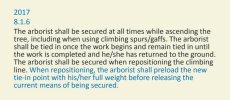Its a common misconception by a lot of SRT climbers that if ya capture the trunk, we can use a dead branch or something with limited strength. You proved that is incorrect. Unless we get our anchor nearly horizontal, the majority of our load is put ON the branch or in this case, on whatever you had in the tree. That's why I stated we should use live and viable branches. And of course, that has nothing to do with the Maverick vs a Butterfly loop vs a Quick Link.had a mishap today while setting up stands. Had a preset I wanted to redo, along with redrilling bolts. I could not get my climbing rope as high as I wanted. It was hitched over a bicycle hook and around the trunk. The bicycle hook came out and the hitch around the tree fell a foot or so. I was only about 6 or 7 feet off the ground, but it was so fast I didn't have time to get scared. I probably fell 1 or 2 feet but the climbing rope caught me and my climbing hitches did their job.
I used a JRB maverick hitch around the trunk. I was able to redo my preset to something more secure.
I am curious if that technique was recommended by someone. Where did you get the idea its safe?
JrbTreeClimbing.com, affiliated with RockNArbor.com


